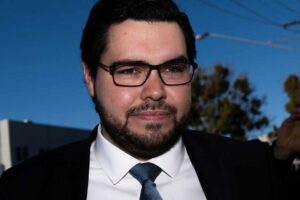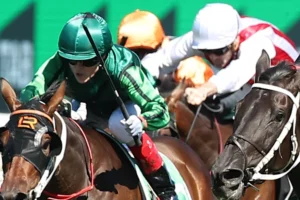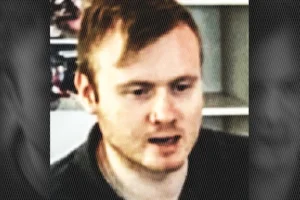
For several decades First Nations artists have done much of the heavy lifting in Australian cultural diplomacy. And now Wesley Enoch as chair of Creative Australia has to fix a damaged sector.
Archie Moore, Tracey Moffatt, Warwick Thornton, Deborah Mailman, William Barton, Tony Albert, Judy Watson, David Gulpilil, Christian Thompson, Ivan Sen, Emily Kam Kngwarray, to name just some of the many who have won accolades for their stunning, original work and taken their place at the peaks of cultural power and influence. Winning hearts and changing minds as they went.
Not so long ago this suggested a long overdue reckoning with the First Peoples; a reckoning that the rest of the world was watching in the detached way that those who can be bothered note what is happening elsewhere.
Australia is diffident about cultural diplomacy, reluctant to exercise its soft power (in anything other than sport), as the abandonment of ABC Asia Pacific TV demonstrated – although the ABC has since revamped its international service.
The global celebration of First Nations artists was a powerful way of showing that modern Australia had thrown off its colonial legacy, had grown into a truly mature and reconciled nation and come to terms with the ancient human heritage that makes it truly unique.
Creative Australia put First Nations stories first in its strategic priorities, Dfat’s cultural grants emphasised the persuasive power of 65,000 years of unique civilisation, and Australia lobbied hard for Unesco recognition of cultural heritage at Gunditjmara and now Murujuga.
Yet as we approach the second anniversary of the decision by most Australians to reject meaningful recognition of First Peoples, the tension at the heart of this international celebration of the talent, stories and unique ways of seeing, being and doing comes clearly into focus.
Is it simple hypocrisy or the old Australian way – one glide forward, two quick steps back?
There are markers. The silence about discussing the referendum or to even consider national truth-telling. The ratty politics rejecting welcomes to country and Aboriginal and Torres Strait Islander flags. The patchy reporting of the coronial findings of institutional racism in the NT Police and the Yoorrook inquiry’s findings of historic genocide. The federal court’s hand-wringing decision that accepted government policies caused wilful destruction of culture and environment in the Torres Strait Islands but that it was unable to do anything about it.
These recent events suggest that coming to terms with the enduring impact of the past is at best the latter, two quick steps back. At worst, to me, it suggests further signs of what Jeremy Bentham once called an “incurable flaw”.
Culture is complicated, cultural diplomacy can take time, but culture might still lead politics
All this came to mind as I stood outside Tate Modern waiting in line under an unusually hot summer sun for my bag to be checked. My English friend and I were on our way to the third floor of the vast former turbine to see the Emily Kam Kngwarray exhibition.
“Why is it on now?” he asked. He knows Australia, has spent time in central Australia and understood how the voice referendum hung heavily there.
It’s a reasonable question. And there are many answers. Some practical, others freighted with meaning. The director of the Tate told the press it was part of her plan to celebrate older female artists who should be considered great masters (mistresses?). The art press buzzed that this was one of three major exhibitions of Indigenous artists in London this summer – the others from Canada and Peru. Indigeneity is “a thing”.
The collaboration to celebrate the “old lady’s” work between the Tate, National Gallery of Australia and the women of Alhalker country began not long after the prime minister, Anthony Albanese, declared there would be a referendum to secure meaningful recognition of First Peoples in the Australian constitution. These big retrospective shows are years in the making, especially ones that require the active involvement of local communities as well as major galleries and high-profile owners around the world.
When the extraordinary show first opened in Canberra just months after the vote, there was sadness about what might have been, about how the exhibition might have celebrated a new beginning.
In London two years later, this is a barely acknowledged backdrop.
Those seeing her work for the first time grapple with what it represents, how someone who only started painting in her 70s produced work as fresh and innovative as any major 20th-century artist – but how it grew out of her knowledge, skill and dreaming.
Like all great artists the work is truly hers, grounded in her unique perspective. What comes as a surprise, to those who have only seen her images in books and posters, is their three-dimensional quality. Kngwarray layered paint to evoke stories of such extraordinary depth that they carry a fourth dimension of infinite time, “everywhen”.
It invites the viewer into a unique way of seeing and being.
Another Australian artist is also celebrated on level 3 of the Tate. Leigh Bowery, who in his short life became a London gay style icon. Both Emily and Leigh speak to a distinctive Australian sensibility and energy. They prove that from an unlikely starting point anything is possible.
Answering my friend’s question, I said I wished the curators had projected The Adventures of Priscilla, Queen of the Desert, where flamboyant gay culture meets the outback, on the wall between the two iconoclastic Australians, to help viewers literally join the dots between the two exhibitions.
Culture is complicated, cultural diplomacy can take time, but culture might still lead politics.
Julianne Schultz an emeritus professor at Griffith University and the author of The Idea of Australia





